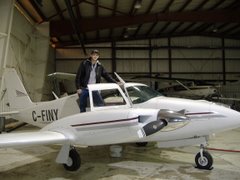*NOTE TO PILOTS* This following post contains nothing new that you haven't already learned. Feel free to skip this one. It is simply an explanation of Density Altitude to enlighten the non-pilot readers, which, I think at this point is all of them. ;)
Density Altitude is a phenomenon that is drilled into every pilot's head right from the start. Defined it would be the altitude that a given mass of air most closely resembles in terms of the air density of the Standard Atmosphere. Simply speaking, that means that if the density altitude of the air at sea level is 2000 ft, it more closely compares to the air density a Standard Atmosphere would have at 2000 ft. A Standard Atmosphere is simply the yardstick aviation uses to compare the properties of air from day to day. A Standard Atmosphere is where at sea level the air temperature is 15° C. Now as we know as air becomes warmer it becomes less dense. That would mean that a 20° C day would have a higher density altitude then a Standard Day. Humidity also affects density altitude - the more humid the air, the less dense it is.
This matters to pilots because an airplane's performance is very closely related to the density altitude. The thinner the air becomes, the less power the engines are able to produce, and the less lift the wings produce. Thin air can also be a good thing, because with it comes less drag, so airplanes are able to fly faster with less resistance meaning better fuel economy. Thinner air also means that all the V-speeds increase. Vs (Stall speed) is higher, Vy (Speed for best climb rate) is higher, Vr (takeoff rotation speed) is higher, etc. It is important to note that it is the True Airspeed (TAS) that is higher, the V speeds in terms of Indicated Airspeed (IAS), which is speed read off the the airspeed indicator, do not change. That is because all IAS is is a reading of pressure difference between normal atmospheric pressure (static pressure) and the ram air pressure measured in the pitot tube. That means it doesn't matter if the air density changes, the difference stays the same. TAS is the speed at which the airplane is actually moving through the air. TAS increases as Density Altitude increases.
This all means that in a high Density Altitude situation, like on a hot 30° C, high humidity day, the airplane is going to be producing less power, and need to accelerate to a higher True Airspeed to take-off. Climb Performance will also suffer. That is why the effects of Density Altitude are drilled into pilot's heads. If they do not calculate the Density Altitude, and apply it to their airplane, they could very well end up expecting the airplane to perform better then it is able, resulting in running out of runway on take-off, or not being able to climb above the trees in time. When an airplane's ceiling is mentioned, that altitude is in Density Altitude. The airplane doesn't really care what altitude it actually is at, only the altitude it thinks its at. If we're overflying a mountainous ridge for example, with the peak at 12000' true altitude, and the airplane's ceiling is listed as 14,000', on a Standard Day of 15° the airplane should be able to fly over the mountains, but if its a hot, humid day, with a Density altitude at sea level of 3000', that means the airplane will perform as if its 3000' higher then it actually is. Meaning it will only be able to climb to 11,000' and it won't make it over the 12,000' mountain.
Density Altitude is a very important concept for a pilot.
Subscribe to:
Post Comments (Atom)




Your blog keeps getting better and better! Your older articles are not as good as newer ones you have a lot more creativity and originality now keep it up!
ReplyDeleteThanks for the compliments! :)
ReplyDeletehiya
ReplyDeletejust signed up and wanted to say hello while I read through the posts
hopefully this is just what im looking for, looks like i have a lot to read.